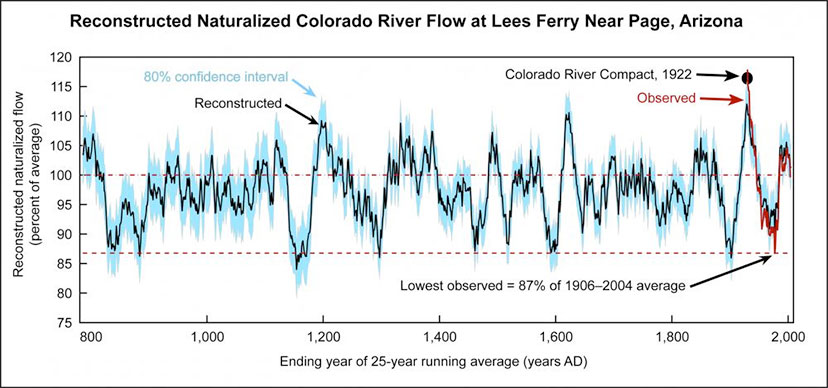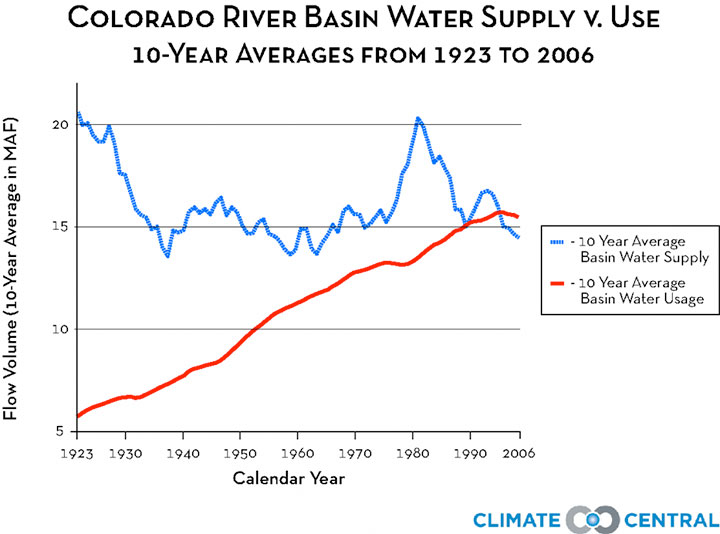We knew this was coming, eventually.
With climate change and long-term drought continuing to take a toll on the Colorado River, the federal government on Monday for the first time declared a water shortage at Lake Mead, one of the river’s main reservoirs.
That’s from an August 16 report in the New York Times. We can find similar sentences in hundreds of news sources. The first declaration, by the US government, of a Lake Mead water shortage. The NYT story, written by written by Henry Fountain, notes that the declaration triggers cuts in water supply that, for now, will affect mainly Arizona farmers.

Beginning next year, certain Arizona farmers will be cut off from much of the water they’ve been extracting from the Colorado River for decades. Smaller reductions are mandated for Nevada, and for Mexico across the southern border.
Larger cuts… are likely in coming years as a warming climate continues to reduce how much water flows into the Colorado from rain and melting snow.
“As this inexorable-seeming decline in the supply continues, the shortages that we’re beginning to see implemented are only going to increase,” said Jennifer Pitt, who directs the Colorado River program at the National Audubon Society. “Once we’re on that train, it’s not clear where it stops.”
The shortage declaration came from the US Bureau of Reclamation, which built dozens of dams all across the American Southwest during the first half of the 20th century, believing that we could grow the historically arid region exponentially — forever? — by constructing reservoir after reservoir.
The Bureau’s forecast predicted that by the end of this year Lake Mead would fall to a level of 1,066 feet above sea level, a level not seen since the reservoir began to fill following the completion of Hoover Dam in the 1930s. At that elevation, the lake would be at 34 percent of capacity.
From the NYT story:
The mandatory cuts, referred to as Tier 1 reductions, are part of a contingency plan approved in 2019 after lengthy negotiations among the seven states that use Colorado River water: California, Nevada and Arizona in the lower basin, and New Mexico, Utah, Colorado and Wyoming in the upper basin. American Indian tribes and Mexican officials have also been involved in the planning.
The shortage announced Monday affects only the lower basin states, but the Bureau of Reclamation may declare a similar shortage for the upper basin, perhaps as early as next year.
The ‘upper basin states’ are Colorado, New Mexico, Wyoming, and Utah.
Most news articles covering the federal declaration have been citing “climate change” as one of the key reasons for the falling lake levels. But scientific studies have indicated that the American Southwest had been unusually wet during the 20th century, and what we are seeing now, in the 21st century, is pretty much in line with past climate patterns.
The University of Arizona has been looking at this kind of ‘prehistoric science’ — estimating Colorado River flows based on tree-ring samples and lake cores, to construct pictures of how the River has behaved prior to the arrival of gasoline engines and coal-fired power plants. The Climate Assessment for the Southwest (CLIMAS) program was established in 1998 as part of the National Oceanic and Atmospheric Administration’s Regional Integrated Sciences and Assessments program. CLIMAS is a collaboration between UA and New Mexico State University.
Here’s a CLIMAS graph indicating that we had unusually good flows during portions of the 20th century. The estimated ‘average flows’ since Time Immemorial have been around 13 million acre-feet per year. Give or take. Some tough times have come and gone. Like, of example, between 850AD and 900AD. And around 1150AD.
The problem, in 2021, isn’t so much a lack of water. Millions of acre feet have flowed down the Colorado River this year. The problem is people using more than what Mother Nature can provide.
As suggested by this chart, published by ‘climate change’ website ClimateCentral.org.
As suggested by this chart, the Colorado River has rather consistently flowed at around 15 million acre-feet per year since the 1930s. But in 1930, the farms, towns and cities in the American Southwest were pulling diverting about 7 million acre-feet out of the Colorado. The remainder was presumably flowing into Mexico, as it had for millennia. According to Climate Central, humans extracting using more water out of the Colorado than it had to give, starting in about 1988.
When you build a reservoir, like Lake Mead, and conclude that you can continually extract more water out than has flowed in, you might expect to see the federal government step in, at some point.
And when you build cities like Phoenix and Las Vegas, in the middle of a desert… and encourage unchecked growth… you’re eventually going to hit a wall.
From the NYT:
Sharon B. Megdal, director of the Water Resources Research Center at the University of Arizona, said she thought the declaration’s focus on the dire state of the river would lead to more efforts in the region to use less water. “I think we’re going to see some adaptation,” she said. “But I don’t know if we can do that much to avoid further cuts.”
With the various tier cuts that were negotiated, “We’re really only talking through 2025,” Dr. Megdal said. “If things continued to get worse and worse, I think there would be some interventions to do even more. We can’t let the river system fail.”
Lake Mead now contains about 12 million acre-feet of water, far below its capacity of nearly 30 million acre-feet. The last time it was anywhere near full was two decades ago.
I agree with Dr. Megdal. We are going to see some adaptation. And if things get worse and worse — which they might — there will probably be some “interventions to do even more.”
Goes without saying. But at least it’s been said.



